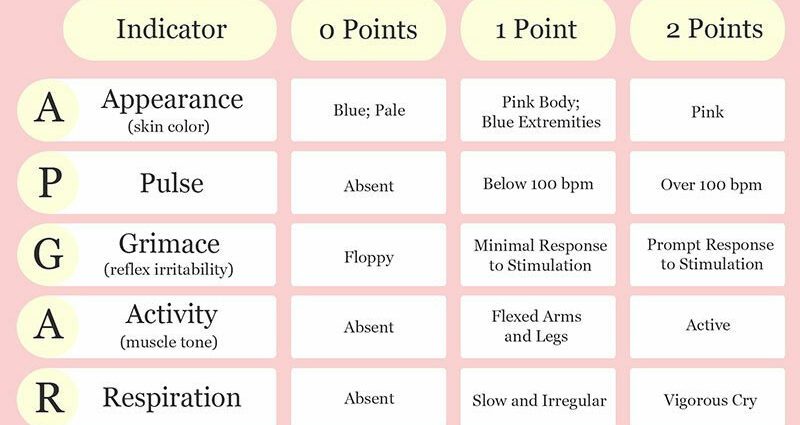Contents
Apgar: definition and interpretation of the Apgar score
Used at birth by health professionals, the Apgar score encompasses a series of tests performed in the first minutes of a child’s life.
Where does the Apgar test come from?
Virginia Apgar was an American anesthetist (1909-1974). After studies at Columbia University, she became the first woman in charge of a department of anesthesiology in the history of the university.
In 1952, Virginia Apgar created an index to assess, from the first minutes, the survival capacity of an infant and the possible need for immediate medical intervention. This is now called the Apgar score.
This test assesses fundamental vital constants 30 seconds to one minute after birth:
- heart rate ;
- breathing;
- muscle tone;
- reactivity (sounds, light);
- coloring of the integuments (skins).
At birth, midwives according to a given grid, evaluate each of these elements and rate them between 0 and 2, to obtain a total score out of 10.
Apgar score calculation
When the child has normal and efficient breathing, all four limbs folded over his body, he has uttered a cry and his skin is pink in color, the score is maximum, 10.
Between 7 and 10, the score is considered to be still normal. There is no need to worry. The baby’s body may be pink, but his feet and hands blue. The first cry may have been delayed due to congestion in the airways.
A score between 3 and 7 may mean that the child has undergone a tiring or painful delivery. Care is then performed: aspiration of phlegm, ventilation… and if necessary, resuscitation procedures are carried out, with specific care.
This score created by Virginia Apgar was generalized in the United States, then throughout the world.
A clue to the development of the child’s future?
This assessment is performed within a few minutes of birth and is repeated five minutes after. A group of experts has indeed proposed the implementation of this second assessment, which makes it possible to better assess the severity of the symptoms and therefore the chances of survival of the child.
Thanks to these tests, it is a question of evaluating the infant’s adaptation to the aerial world in the first minute after childbirth, then 5 minutes after and if necessary 10 minutes thereafter. A child with a good Apgar score may very well develop complications within hours. Conversely, a child with an unfavorable Apgar score can then present a very good evolution.
This score has no long-term value. It does not in any way predict the child’s future physical and intellectual capacities.
A reliable score
More than fifty years after its invention, the Apgar test is still performed systematically at birth and its reliability is not questioned. Its simplicity and the absence of special equipment are its major advantages.
However, it remains an imperfect indicator of health status at birth and may be supplemented by other tests depending on the situation, such as examining blood gases from the umbilical cord.
In 1973, Virginia Apgar became the first woman to be awarded the Columbia Medicine Gold Medal. In honor of his work, his portrait was engraved on a commemorative stamp issued in 1994.
The Apgar score has saved millions of newborns and today remains one of the most widely used exams in many countries.
A link with supposed hyperactivity
Danish researchers conducted a study to determine whether a low Apgar score might play a specific role in the later development of ADHD.
To do this, the specialists relied on a series of databases, covering a total of nearly one million children, born between 1988 and 2001.
In an article published by the Journal of Pediatrics, they first indicate that a higher incidence of cases has been noted in the following situations:
- male child;
- intrauterine growth retardation;
- younger mothers;
- low socio-economic level;
- and parental psychiatric history.
Regarding the Apgar score (at five minutes), it was found that babies who had a result between 1 and 4 were at a 75% increased risk of ADHD compared to children whose score was of 9 or 10.
The probability increases by 63% with a score of 5 or 6. Prof. Jean-Jacques Baudon specifies, for the International Journal of Medicine: « It is possible that these two anomalies share a common cause, or that a low Apgar score is one of the factors leading to ADHD ”.










